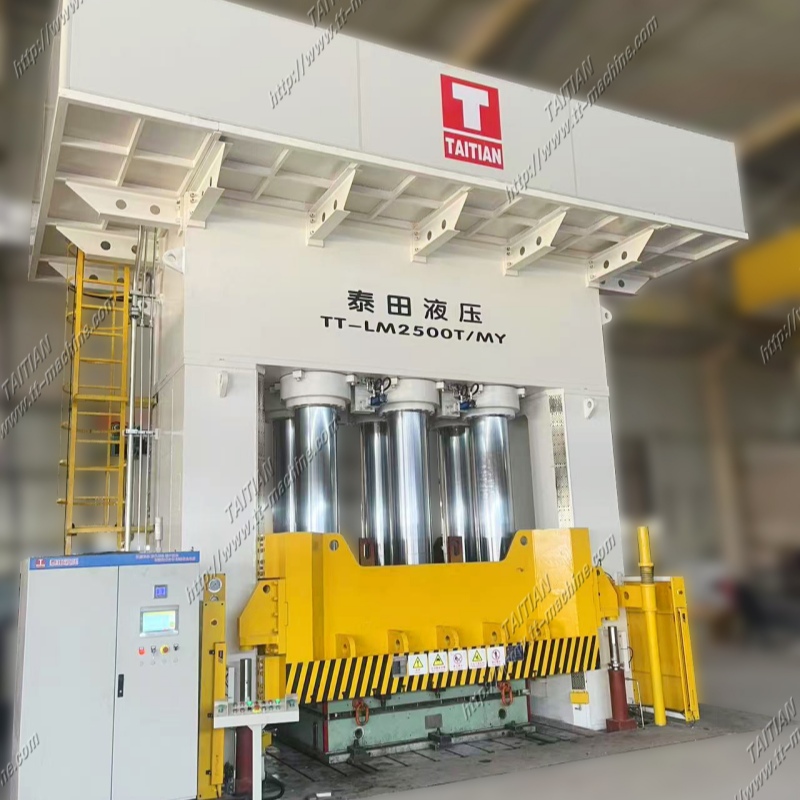Composites Hydraulic Press: Revolutionizing Manufacturing in the Composite Industry
2025-04-17
The composite materials industry has been on a steady rise, thanks to their versatile applications and high-performance characteristics. From aerospace and automotive to construction and sports equipment, composites are now integral to various industries. At the heart of the production of these high-tech materials is an often-overlooked piece of equipment: the composites hydraulic press.
In this blog, we will explore the importance of composites hydraulic presses, how they work, and why they are indispensable in modern manufacturing processes.
What is a Composites Hydraulic Press?
A composites hydraulic press is a heavy-duty machine used to apply high pressure and heat to composite materials during the manufacturing process. This press uses hydraulic force to mold or bond composite layers, such as carbon fiber, fiberglass, and resin, into the desired shapes and sizes.
Unlike traditional presses that rely on mechanical force, hydraulic presses provide a more controlled and even distribution of pressure. This makes them ideal for applications in the composite industry, where precision and consistency are paramount. The press’s ability to control pressure, temperature, and time allows manufacturers to produce high-quality composite parts with minimal defects.
How Does a Composites Hydraulic Press Work?
The functioning of a composites hydraulic press revolves around the use of hydraulic fluid to exert force. Here is a simplified breakdown of how the process works:
1. Loading the Mold: The first step involves placing the composite material (such as a pre-impregnated fabric or resin) into a mold or tool. The mold is designed to shape the composite material into the desired form.
2. Application of Pressure: The hydraulic press uses a hydraulic pump and piston system to apply force to the material in the mold. The pressure forces the material into every crevice of the mold, ensuring that the composite material fills all spaces and takes on the precise shape of the mold.
3. Heating: In many cases, heat is applied simultaneously to cure the composite material. This helps to solidify the resin or bonding agent used in the composite layers, giving the final product its desired strength and durability.
4. Curing Time: The press maintains the pressure and temperature for a specified amount of time to ensure the composite material cures properly. The curing time depends on the type of resin, material, and desired properties of the finished part.
5. Release: After the curing process is complete, the pressure is released, and the composite part is removed from the mold. The result is a strong, lightweight, and precisely shaped composite component.
Advantages of Composites Hydraulic Presses
Composites hydraulic presses offer a variety of advantages that make them essential in the production of high-quality composite materials:
1. Precision and Consistency: One of the most significant benefits of hydraulic presses is their ability to apply consistent pressure across the entire surface area of the mold. This ensures that the composite material is evenly distributed and the final product is free from defects such as air pockets, voids, or uneven curing.
2. Versatility: Hydraulic presses are highly versatile and can be used for a wide range of composite materials, including carbon fiber, fiberglass, and aramid fibers. They can handle both thermosetting and thermoplastic materials, making them ideal for various applications in industries like aerospace, automotive, and marine.
3. Customization: The pressure, temperature, and curing time can be adjusted depending on the requirements of the composite material. This customization allows manufacturers to fine-tune the production process to meet the specific needs of their products.
4. Scalability: Hydraulic presses can be used for both small batch production and large-scale manufacturing. The machines can be configured to produce components of varying sizes, from small parts like brackets to large structural components.
5. Energy Efficiency: Compared to traditional mechanical presses, hydraulic presses are often more energy-efficient. The ability to control pressure and temperature in a precise manner reduces waste and energy consumption during the manufacturing process.
6. Improved Part Strength: Because hydraulic presses can apply uniform pressure, the resulting composite parts tend to have better mechanical properties. The parts are less likely to suffer from weak spots or inconsistent material distribution, which could lead to failure under stress.
Applications of Composites Hydraulic Presses
Composites hydraulic presses are used in a variety of industries where lightweight, high-strength materials are crucial. Some of the key applications include:
1. Aerospace: In the aerospace industry, composites are used extensively for manufacturing parts like wing components, fuselage sections, and interior fittings. Hydraulic presses help produce lightweight and durable parts that are vital for the performance and safety of aircraft.
2. Automotive: The automotive industry uses composites to reduce vehicle weight and improve fuel efficiency. Hydraulic presses are used to manufacture components like body panels, bumpers, and structural parts that need to be both strong and lightweight.
3. Marine: Composites are also widely used in the marine industry for producing parts like boat hulls, decks, and propellers. Hydraulic presses help create parts that are resistant to corrosion while maintaining strength and performance in harsh marine environments.
4. Sports Equipment: Many sports equipment manufacturers rely on composites to make high-performance gear, including bicycle frames, golf clubs, and skis. Hydraulic presses ensure that these products are both lightweight and durable, offering top-tier performance to athletes.
5. Construction: Composites are used in the construction industry for producing panels, beams, and other structural components. Hydraulic presses ensure that these parts are both sturdy and capable of withstanding the pressures of the construction environment.
Conclusion
The composites hydraulic press is a vital piece of equipment that has revolutionized the way composite materials are manufactured. By providing precise control over pressure, temperature, and curing time, these presses enable manufacturers to produce high-quality, durable, and lightweight parts for a variety of industries.
As the demand for composite materials continues to grow, hydraulic presses will remain at the forefront of manufacturing innovation, helping industries create the advanced materials needed for tomorrow’s products. Whether it’s in aerospace, automotive, or sports, the composites hydraulic press ensures that every part is made to the highest standards, contributing to the continued advancement of technology.



